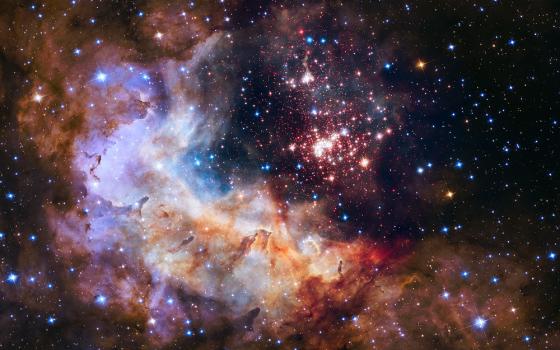From the dawn of our species, what we know about the universe has come from the power of observation, that is, what we can observe in a light-filled universe. In the 13th-century Oxford theologian Robert Grosseteste described the beginning of all physical life from light. One of his major works De Luce begins with God's creation of a single point of light which, through expansion and extension, he claimed, evoked the entire physical order into existence. The expansion of light replicating itself infinitely in all directions, he speculated, is the basis of the created world.
Grosseteste was not too far from modern physics. In the early part of the 20th century, Albert Einstein announced his theory of general relativity (1916) in which he rewrote the rules for space and time that had prevailed for more than 200 years, since the time of Newton. Newton's physics stipulated a static and fixed framework for the universe based on concepts of absolute space and absolute time which were considered independent of one another. Instead, Einstein showed that space and time form a continuum and are part of the physical fabric of the universe. Einstein's revolutionary discovery was based on light and the equivalence of matter and energy which permeate the universe.
A year after Einstein announced his theory of general relativity, he predicted that the speed of massive objects would distort space-time, sending out gravitational waves or tiny ripples reverberating in the cosmos that can both stretch and shrink; however, until September 2015 the existence of gravitational waves had not been directly detected. Their recent discovery is truly remarkable because they were not seen but heard! Using powerful laser electromagnetic wave detectors, scientists could amplify the noise of the waves and measure them. Scientists were listening to nature, like a stethoscope on the heart.
Black holes are collapsed giant stars which become like cosmic sink holes that trap light and matter. They have been known to exist in the universe but until now there has been little evidence of their existence. The gravitational wave discovery is based on the cosmic peregrination of black holes. Scientists speculate that about 1.3 billion years ago two black holes swirled closer and closer together until they crashed in a furious bang. Each black hole packed roughly 30 times the mass of our sun into a minute volume, and their head-on impact came as the two were approaching the speed of light. The staggering strength of the merger gave rise to a new black hole and created a gravitational field so strong that it distorted spacetime in waves that spread throughout space with a power about 50 times stronger than that of all the shining stars and galaxies in the observable universe. This is what scientists at the Laser Interferometer Gravitational-Wave Observatory (LIGO) detected last September. They actually heard and recorded the sound of two black holes colliding a billion light-years away, producing a fleeting chirp which was recorded. This was the first time in the history of the cosmos that the human ear could actually listen to the secrets of nature; a new hotline to nature. Dr. Kip Thorne, one of the leading scientists in the discovery, said that until now scientists had only detected warped space-time when it is calm. The detection of the black hole collision revealed another side of nature's gravitational waves that could be likened to the ocean roiled in a storm with crashing waves.
The discovery of gravitational waves is truly awesome. The fabric of the universe is like a trampoline that can stretch or shrink due to massive objects like black holes colliding or like a mattress shaking when a sleeper rolls over, producing ripples of gravity or gravitational waves. This is no static, mechanistic universe; rather, our universe is a mysterious ocean of energy and matter in which space and time are interwoven and dynamic, able to stretch, shrink and jiggle. Even more incredible is the confirmation of black holes, the bottomless gravitational pits from which not even light can escape. The discovery of gravitational waves now gives scientists a new opportunity to understand the early universe and the powerful cosmic events that created them.
But what does this mean for us? Well, on the macro level not much. Life goes on with its ups and downs, births and deaths, good days and bad days, failures and achievements. But on a deeper level the discovery of gravitational waves tells us that science is living between mystery and discovery. It is as if astronomers are listening in on cosmic oracles and not yet quite knowing what to make of the strange sounds. The elastic nature of space-time almost makes time irrelevant in the vast universe, which means searching for the origin of the universe may not be, as we conceived on the human level, looking back; rather it may mean looking forward. The existence of black holes or massive star collapse, also points to the eerie presence of death in the universe from which mysteriously new elements of life emerge and converge.
Einstein did not believe in a personal God, but he did maintain that mystery permeated the universe. Reportedly he said to one of his skeptic acquaintances, "Try and penetrate with our limited means the secrets of nature and you will find that, behind all the discernible laws and connections, there remains something subtle, intangible and inexplicable. Veneration for this force beyond anything that we can comprehend is my religion. To that extent I am, in fact, religious."
The more we comprehend the universe, the more we see how truly incomprehensible it is — which leaves room for religion — but not a religion of the past or religion based on ancient cosmology. The mysterious new universe calls for new religion, a renewed sense of divine mystery in the cosmos, a new religious myth, a new narrative that draws us into these cosmic waves that are, in some fundamental way, the source of our lives. We need a new religious sense of time and eternity as operative in the moment of occupied space, not as future events but possible events. As Christians in this vast, dark, wavy universe, what do we hope for? It is time to take a few cues from science, namely: 1) change the religious paradigm when the right time comes, 2) let go let God and 3) trust nature to generate new life. Scientists try to collapse mystery into data, but we believe in the divine mystery at the heart of matter and, for this reason alone, we should be the most trusting of nature because we believe that God is in the waves.
[Ilia Delio, a member of the Franciscan Sisters of Washington, D.C., is the Josephine C. Connelly Endowed Chair in Theology at Villanova University. She is the author of sixteen books and the general editor of the series Catholicity in an Evolving Universe. Her newest book is Making All Things New: Catholicity, Cosmology and Consciousness (Orbis Books 2015).]

